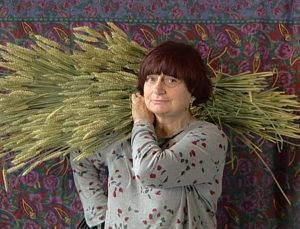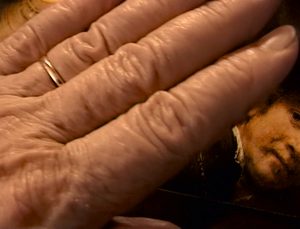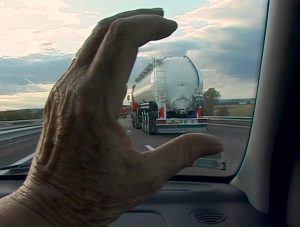Agnès Varda: The Gleaner of All Things
Macy Meyer

Varda carrying a bushel of wheat, conveying that she, too, is a gleaner.
In The Gleaners and I (Les glaneurs et la glaneuse, 2000), Agnès Varda creates an intimate portrait of French life using the centuries-old practice of gleaning as her central theme. She considers how gleaning is manifested in the everyday experiences of the country’s most poor and marginalized. In its original definition, gleaning simply refers to scrounging for leftover food after a harvest, but Varda expands the term’s meaning to include the rediscovery of lost things, and the attribution of new significance to neglected items and people. In this sense, Varda is the ultimate gleaner. She gleans objects, images and human beings — including herself as she carries out a self-aware and self-inquisitive journey.
Varda’s film is not a documentary, but an essay film charged with the task of undertaking an open-ended investigation. This statement sounds elusive, but a common aspect of essay films is their elusiveness and refusal to be confined to specific, rigid definitions. As Laura Rascaroli describes in “The Essay Film: Problems, Definitions, Textual Commitments,” the essay film is a sort of hybrid form that sits at the intersection of fiction and nonfiction. Rascaroli lists many typical features of the essay film including a nonlinear narrative, frequent usage of a voiceover and how essay films unfold in ways that are both exploratory and digressive (Rascaroli 27). But she concludes that of the many common aspects, the ones “that are most frequently identified in the essay form, both literary and filmic, two stand out as specific, essential, and characterizing: reflectivity and subjectivity” (Rascaroli 25). Varda’s film matches with this definition of the essay film with its usage of these two elements. The film offers a thought-provoking, intimate reflection on the idea of gleaning without coming to a single conclusion at the end, but the film does this reflection as an almost autobiography as the film is filtered through Varda’s subjectivity and is ultimately about her discovery of self. The film also makes use of reflexivity – the ability to make the audience aware of the filmmaking process – as the film narrative unfolds in a self-conscious manner. The film thinks of itself as it unfolds, creating the idea that the film is not complete even as it plays out for the viewer, and that the film is more an open interpretation instead of offering a distinct final answer. All of these elements allow for an essay film like The Gleaners and I to be as lyrical and captivating as it is.
With a first watch, The Gleaners and I seems like a socio-political commentary on how the French government neglected its people to the point where they must succumb to being scavengers. This idea is certainly in play as the government is scrutinized as being unethical, but the film is more an active self-reflection as Varda analyzes her own gleaning and herself as an object to be gleaned. In the opening, Varda appears at a museum in Arras studying a famous painting of a gleaning woman by Jules Breton. The film shows us a close-up of the painting, La Glaneuse, and then cuts to a wide shot of the museum where we see Varda standing directly next to the painting, holding wheat and posing just the same as the female gleaner. The film cuts to a medium shot on Varda with her voiceover saying, “there is another woman gleaning in this film, that’s me.” This scene creates the idea that while Varda is studying other modern gleaners, she is really creating a self-portrait. This self-portrait is as a gleaner not of wheat or grains, but of images or people, which is supported when she drops the bale over her shoulder to pick up a portable digital video camera. This is ultimately a reflexive moment, as Varda knows just four minutes into the film that she will undergo this practice of gleaning for the duration of the film and invites the audience to join her.
To understand Varda’s self-portrait, the audience must look at Varda as she actually gleans. Varda begins gleaning images by finding older, forgotten objects and then reapplying a level of significance to the objects. First, she finds the many paintings in galleries of the traditional female gleaners and realizes their resonances in France even in the 2000s. Yet this motif of her gleaning objects is most evident when she examines the souvenirs she has brought back from Japan. With an overhead camera angle, Varda opens her suitcase and begins a montage of quick, consecutive close-up shots of the objects: a handful of postcards, stamps, papers and an assortment of other collections. Varda shows off each object to the viewer, establishing that each finding is important to her. These objects become important as they, like the museum paintings, carry the weight of history as they conjure memories of her trip.

Varda’s gesture plays a game of hide and seek with a self-portrait painted by Rembrandt
This scene is also one of her most intimate moments. After the successive shots of her postcards that depict Rembrandt paintings, the camera drifts to an extreme close-up on her hand, slowly panning over her wrinkled fingers in a languid motion, as if her hands distracted her from the other images. The examination is no longer on the items from her travels, but on her hands. This draws a direct connection between her body and the postcards of Rembrandt paintings. This connection is fascinating because Rembrandt was a founder of the self-portrait, which ultimately links Rembrandt’s self-identifying portrait with Varda’s creation of her own filmic self-portrait. But as Kate Ince points out in her essay “Feminist Phenomenology and the Film World of Agnès Varda,” gender reversal is poignant in this moment. Varda’s hand, which obstructs Rembrandt’s face, “displaces Rembrandt’s mastery of the conventional painted self-portrait — neatly, modestly, and without drawing attention to what it is doing in any way, but displaces it nonetheless. A woman’s perception and hands are explicitly privileged at the expense of a man’s in this sequence…” (605). This moment is both highly subjective and reflective. With the alignment of a feminine perception instead of the male artist, the audience is greatly attuned to Varda’s personal thoughts. Further, the self-reflexivity shows that as Varda is realizing her own changed self through an analysis of her aged hands, she is also examining how the identity of a portraitist or artist has shifted with time, too. This idea also ties in with the examination of how the idea of gleaners has evolved. We are reminded here that Varda is acknowledging her gleaner identity and is hoping to glean meaning from herself. The hands thus become a consubstantial element, allowing Varda to become both the gleaner and the gleaned – the portrait and the portraitist – which is only possible through the subjectivity and reflectivity common in an essay film.
The actual features of the essay film are crucial for how to understand the film. By looking at Varda’s gleaning, it becomes clear that the film is less about what gleaning is, but how it has changed and how it can be used for self-discovery. The film follows multiple definitions of gleaning: gleaning of the physical, but also of the psychoanalytical and political. As the actual term is explored in multiple forms across time periods, gleaning becomes, as Timothy Corrigan describes in “The Essay Film as a Cinema of Ideas,” an “essayistic activity” (233). This activity allows the film to be self-reflexive and not just subjective or reflective. By being able to glean images for the film, Varda can begin to understand herself and her place as an object that also needs to be redeemed from the pile of excess things. This is most evident in those moments of Varda filming in the car as she travels. The shots of the cars and trucks on the highway speeding past become meaningful as Varda observes the fleeting moments it takes for the car to enter then leave the frame. In some instances, Varda even reaches a hand out, creates a circle and attempts to capture the cars with the hand opening and closing like a lens. But she cannot “retain things passing” with her hands and realizes that she, too, is just a passing object. This realization of the fleeting and “of the self in a passing world” allows the film to sketch “the passing and loss of self through the world” (Corrigan 233). As Varda undergoes this search of identity and creation of a self-portrait, she must attempt to succeed at retaining things passing, but that can only be done through gleaning. Although Varda cannot retain passing things with her hands, she can with the video camera. Therefore, it is only possible to find oneself within this passing world through the film’s essayistic activity of gleaning. The gleaning in this film becomes less about gleaning food, but gleaning – or finding meaning for – the self by using the medium of the essay film.

Again emphasizing her hands, Varda playfully “grabs” a truck through the window of her vehicle.
This scene also expands on one of the common themes of the film: the ability of the new digital cameras to act as a tool for gleaning and discovery. Varda is only able to film her hands and objects at such an intimate proximity due to this new technology. The technology begins a meditation on the newness and the potential possibilities of the digital camera. As the film unfolds, it appears that Varda is in awe of the images she can glean via that new portable camera and it is the camera that eventually allows her to glean.
Gleaning within the film takes shape not as a desperate act, but as an art through Varda’s own gleaning. Those interviewed are shown as being crafty and resourceful, and are looked at not with pity, but with solidarity and understanding. Varda champions herself as a gleaner, too, and seems to understand the burden of those she interviews – whether they be young kids, oyster collectors, rural peasants or an urban teacher – because she is also gleaning along with them. In a way, Varda even gleaned the concept of gleaning within the film by showing how it can be a tool of self-study and discovery. In this sense, Varda is the gleaner of all things.
Works Cited
Corrigan, Timothy. “The Essay Film as a Cinema of Ideas.” Global Art Cinema: New Theories and Histories, ed. Rosalind Galt and Karl Schoonover. New York: Oxford University Press, 2012.
Ince, Kate. “Feminist Phenomenology and the Film World of Agnès Varda.” Hypatia, vol. 28, no. 3, 2013, pp. 602-617.
Rascaroli, Laura. “The Essay Film: Problems, Definitions, Textual Commitments.” Framework, vol. 49, no. 2, 2008, pp. 24-47.

